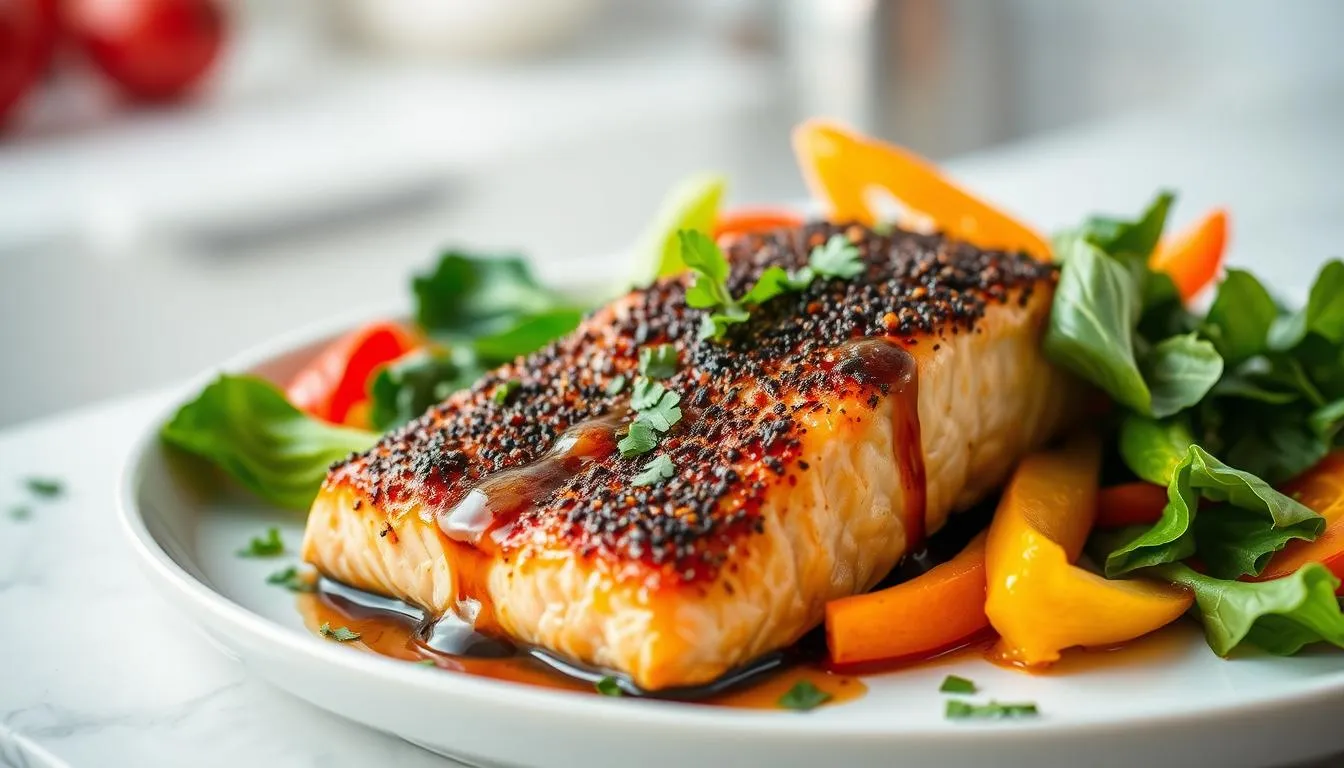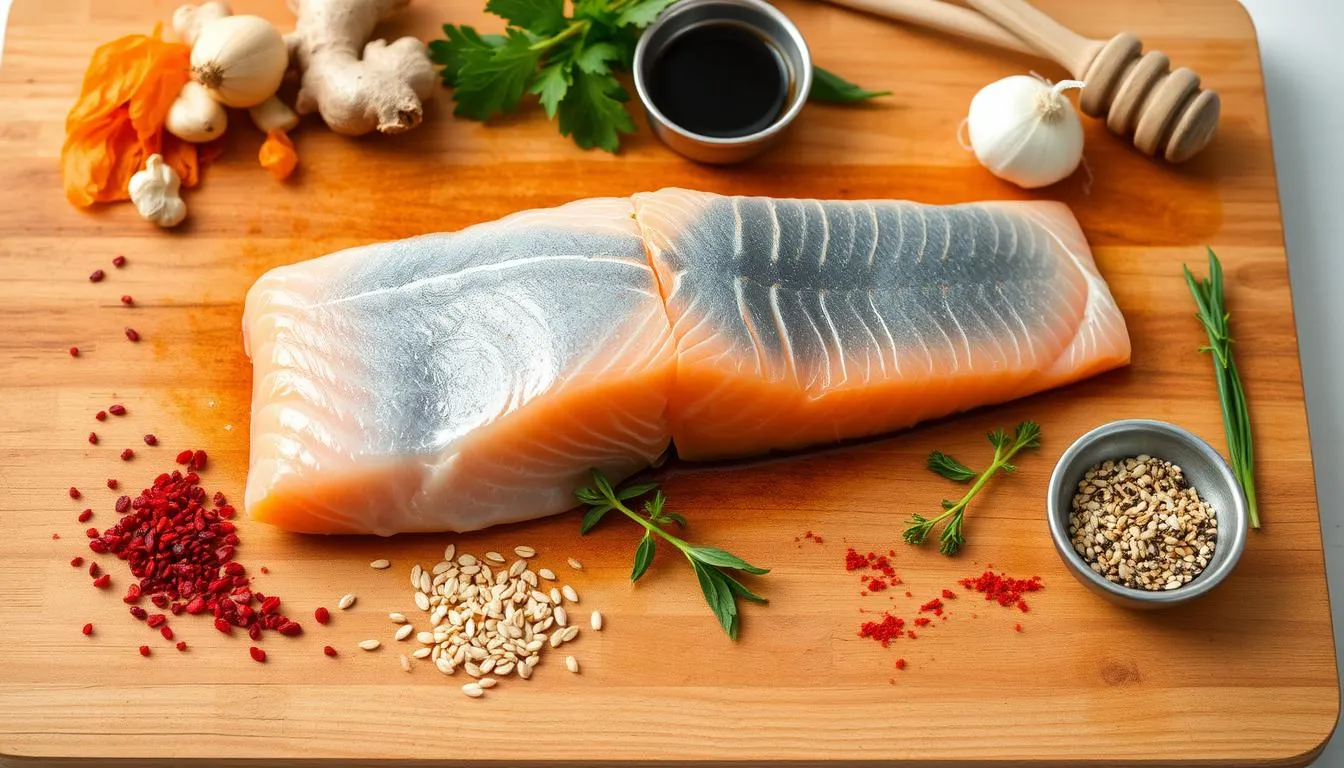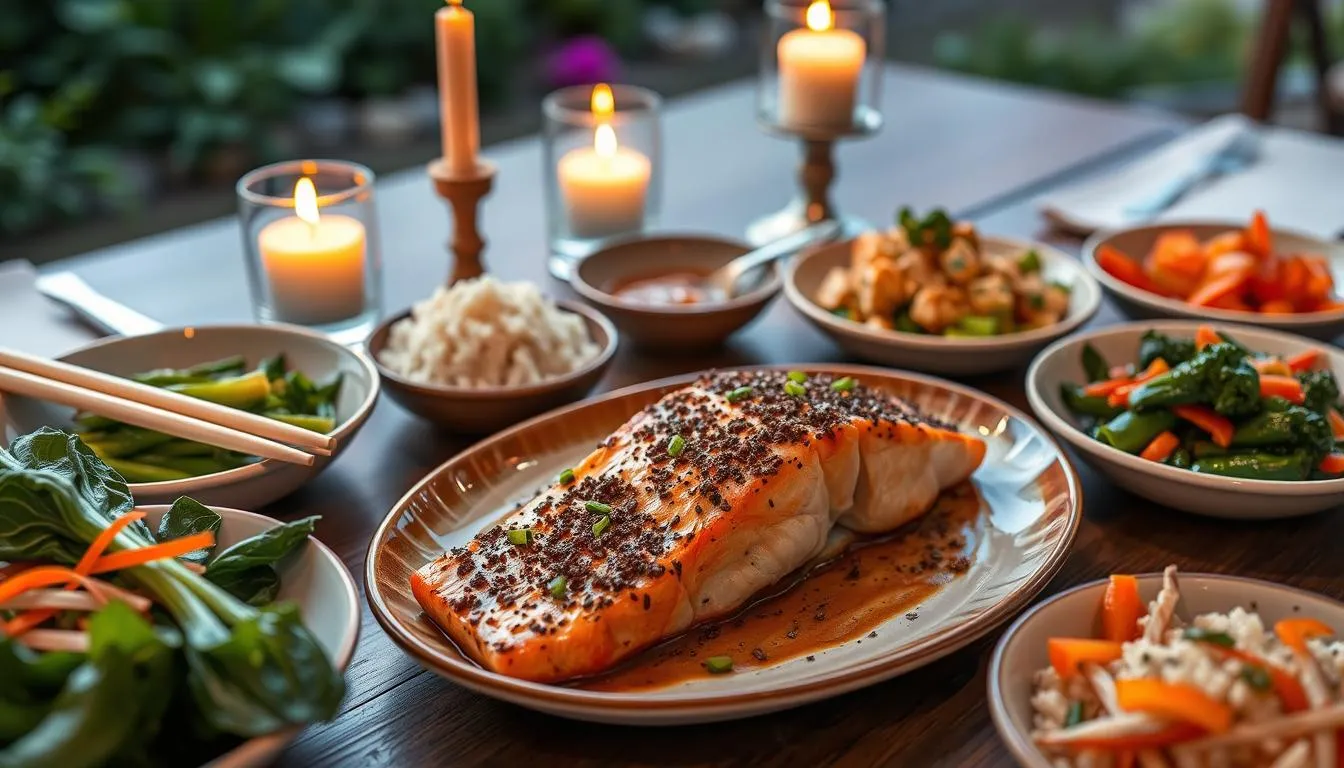You can make a tasty and healthy dish by mixing salmon with Asian spices. This easy recipe uses a simple rub. It’s great for any meal.
This recipe is easy and full of nutrients and flavor. The Asian rub gives the salmon a unique taste. It’s perfect for both experienced and new cooks.
Key Takeaways (salmon asian rub recipe)
- You can make a delicious and healthy salmon dish using an easy salmon recipe and an Asian-inspired rub.
- This Asian-inspired rub recipe is perfect for easy cooking, as it requires minimal ingredients and preparation time.
- The salmon recipe is packed with nutrients and flavor, making it a great option for a healthy meal.
- The Asian-inspired rub adds a unique and delicious flavor to the salmon.
- This easy cooking recipe is perfect for anyone looking to make a delicious and healthy meal.
- You can use this recipe to make a flavorful salmon dish that is perfect for any occasion.
- The Asian-inspired rub recipe is a great way to add some variety to your cooking routine.
Understanding Asian-Inspired Salmon Rubs
Exploring Asian-inspired salmon rubs reveals a blend of traditional spices and new cooking methods. The secret to a great rub is mixing Asian spices like soy sauce, ginger, and garlic with other flavors. This enhances the taste of your salmon.
Preparing salmon can be done in two ways: dry rubs and marinades. Dry rubs are easy and clean, while marinades offer a deeper flavor. Spices like sesame oil and five-spice powder make a dry rub that adds a rich taste to your salmon.
Traditional Asian Spice Combinations
Asian spice mixes often include soy sauce, ginger, and garlic. These can be mixed with spices like cinnamon and star anise for a unique rub. Using Asian spices in your rubs brings a special flavor to your salmon that’s hard to get with other methods.
Benefits of Dry Rubs vs. Marinades
Dry rubs and marinades each have their own advantages and disadvantages. Dry rubs are quick and easy, while marinades offer a stronger flavor. But, marinades can be messy and take more time. Asian spices make a dry rub that’s tasty and simple to use.
Cultural Significance of Asian Seasonings
Asian seasonings like soy sauce and ginger hold deep cultural value in many Asian countries. They’re key in traditional dishes and valued for their taste and health benefits. Using Asian spices in your rubs adds cultural authenticity and explores the rich tastes of Asian food.
Whether you prefer dry rubs or marinades, Asian spices bring a unique flavor to salmon dishes. Their cultural importance and rich taste make them a great choice for adding depth to your cooking and exploring Asian cuisine.
Essential Ingredients for Your Salmon Asian Rub Recipe
To make a tasty Asian-inspired salmon rub, you’ll need some key salmon ingredients. These include salmon fillets, soy sauce, brown sugar, garlic, ginger, and sesame oil. These Asian spices will make your dish taste amazing and smell great.
Here’s what you’ll need for your recipe:
- Salmon fillets
- Soy sauce
- Brown sugar
- Garlic
- Ginger
- Sesame oil
These salmon ingredients will help you make a dish that’s both delicious and flavorful. The Asian spices will add a rich taste and aroma. By using this recipe, you’ll create a tasty Asian-inspired salmon rub that will wow your family and friends.
| Ingredient | Quantity |
|---|---|
| Salmon fillets | 4-6 fillets |
| Soy sauce | 1/4 cup |
| Brown sugar | 2 tablespoons |
| Garlic | 3 cloves |
| Ginger | 1 tablespoon |
| Sesame oil | 2 tablespoons |
Selecting the Perfect Salmon Cut
Choosing the right salmon cut is key for a tasty Asian-inspired dish. You need a cut that can handle bold flavors and textures well. Fresh salmon is ideal, but frozen salmon works too if it’s frozen right.
There are many salmon cuts to pick from: fillets, steaks, and whole salmon. Fillets are popular for their delicate taste and easy cooking. Steaks offer a meaty texture that’s great with strong flavors. Whole salmon makes a stunning presentation.
Fresh vs. Frozen Salmon Options (salmon asian rub recipe)
Fresh salmon is top-notch, but it can be pricey and hard to find. Frozen salmon is a budget-friendly alternative that’s just as tasty. Just ensure the frozen salmon was frozen correctly to keep its flavor and texture.
Different Salmon Varieties for Asian Rubs
Several salmon types are perfect for Asian rubs. King salmon, Sockeye salmon, and Atlantic salmon are favorites. Each has its own taste and texture, so pick one that fits your dish.
How to Check for Freshness
For fresh salmon, look for a nice smell, firm feel, and shiny look. Ask your fishmonger for the freshest salmon cuts. These tips will help you pick the best salmon for your dish.
| Salmon Variety | Flavor | Texture |
|---|---|---|
| King Salmon | Rich and buttery | Firm and meaty |
| Sockeye Salmon | Smoky and rich | Firm and flaky |
| Atlantic Salmon | Mild and delicate | Soft and flaky |
Preparing Your Salmon for the Rub
To get the perfect salmon preparation, start with the basics before adding the rub. These steps ensure the rub sticks well and the salmon cooks right.
First, pat the salmon dry with a paper towel. This removes extra moisture, helping the rub application stick better. Then, remove the skin if it’s there. This lets the rub get deeper into the fish.
Scoring the salmon’s flesh is another good move. This creates more surface for the rub to stick to, making the dish taste better. It also helps the salmon cook evenly, avoiding overcooking or undercooking.
Here are some important tips for salmon preparation:
- Handle the salmon gently to avoid damaging it.
- Let the salmon come to room temperature before rubbing it. This helps it cook evenly.
- Don’t score the salmon too much, as it can break apart while cooking.
By following these steps and tips, you’ll make a tasty Asian-inspired salmon dish. The right rub application and salmon preparation are key to unlocking the dish’s full flavors and textures.
Step-by-Step Rub Application Technique
Applying the Asian-inspired rub is key to great flavors in your salmon. Start by patting the salmon dry with a paper towel. This removes excess moisture, helping the rub stick better.
Then, sprinkle the rub over both sides of the salmon. Make sure to cover all surfaces. Use your hands or a spatula to press the rub onto the fish. This ensures it sticks well.
Letting the salmon rest is also important. It lets the flavors soak into the fish. Rest it for at least 30 minutes to an hour before cooking.
Here are some tips for applying the rub:
- Use the right amount of rub: too little and the flavors won’t come through, too much and it can overpower the fish.
- Don’t over-handle the fish: gentle handling will help prevent the rub from falling off.
- Let it rest: allowing the salmon to sit for a while will help the flavors meld together and the fish to cook more evenly.
By following these steps and using the right coating methods, you’ll get a delicious Asian-inspired salmon dish. Don’t forget the resting time for the best results.
| Step | Description |
|---|---|
| 1 | PAT dry the salmon with a paper towel |
| 2 | SPRINKLE the rub evenly over both sides of the salmon |
| 3 | LET it rest for at least 30 minutes to an hour |
Cooking Methods for Asian-Rubbed Salmon
There are several ways to cook Asian-rubbed salmon, like grilling, baking, and pan-searing. Each method can make the salmon taste great. But, it’s key to know how to cook salmon well to get the best results.
Think about the salmon type and how you like it cooked. Grilling gives a crispy outside and a soft inside. Baking keeps the fish moist. Pan-searing creates a crunchy crust.
Some top cooking methods for Asian-rubbed salmon are:
- Grilling: perfect for a crispy exterior and a smoky flavor
- Baking: ideal for a moist and flaky texture
- Pan-searing: great for a crispy crust and a tender interior
It’s important to cook the salmon to 145°F (63°C) for safety and taste. This ensures it’s cooked just right.
Learning different cooking methods and salmon cooking techniques lets you make many tasty dishes. These dishes highlight the special flavors of Asian-rubbed salmon.
| Cooking Method | Temperature | Cooking Time |
|---|---|---|
| Grilling | 400°F (200°C) | 4-6 minutes per side |
| Baking | 400°F (200°C) | 12-15 minutes |
| Pan-searing | medium-high heat | 3-4 minutes per side |
Perfect Temperature and Timing Guide
Cooking salmon right is key for safety and taste. You want it cooked just right, not too much or too little. Knowing the internal temperature, cooking time, and how to check for doneness is important.
The best cooking temperature for salmon is between 145°F and 150°F. This ensures it’s cooked well but stays moist and flavorful. A food thermometer is a great tool to check the internal temperature.
Internal Temperature Guidelines
Here are some internal temperature guidelines:
- Salmon cooked to 145°F is medium-rare, with a pink color and tender texture.
- Salmon cooked to 150°F is medium, with a firmer texture and lighter pink color.
- Salmon cooked to 155°F or higher is well-done, with a firm texture and white color.
Cooking Time Charts (salmon asian rub recipe)
Cooking time varies based on salmon thickness and method. Here’s a general guide:
| Cooking Method | Thickness | Cooking Time |
|---|---|---|
| Grilling | 1-2 inches | 4-6 minutes per side |
| Baking | 1-2 inches | 8-12 minutes |
| Pan-searing | 1-2 inches | 3-5 minutes per side |
Doneness Indicators
Checking for doneness isn’t just about temperature. Look for these visual cues too:
- Flakiness: Cooked salmon should flake easily with a fork.
- Color: Cooked salmon should have an opaque color, with a slight pink or white tint.
- Texture: Cooked salmon should be firm but tender and moist.
Pairing Suggestions and Side Dishes
When serving Asian-rubbed salmon, the right sides and drinks can make it even better. Try different pairings to find the best match for the dish. Serve it with Asian sides like stir-fried veggies or steamed rice for a complete meal.
For wine, a dry white like Sauvignon Blanc or Pinot Grigio works well. You can also try sake or Asian cocktails for something special.
Asian-Inspired Side Dishes (salmon asian rub recipe)
Here are some Asian sides that go great with salmon:
- Stir-fried veggies, like broccoli or bell peppers
- Steamed rice or noodles
- Roasted veggies, such as asparagus or Brussels sprouts
Wine and Beverage Pairings (salmon asian rub recipe)
Here are some wine and drink options:
- Sauvignon Blanc or Pinot Grigio for a crisp taste
- Sake or Asian cocktails for a unique flavor
- Asian beers, like lagers or pilsners, for a light choice
Exploring different sides and drinks can make your meal memorable and tasty. It highlights the flavors of the Asian-rubbed salmon.
Storage and Leftover Tips
Proper handling and storage are key for keeping your Asian-rubbed salmon safe and tasty. Cooked salmon can stay in the fridge for up to three days or be frozen for later. To freeze, put the salmon in an airtight container or freezer bag. Make sure to remove as much air as you can before sealing.
This method prevents freezer burn and keeps your salmon fresh for up to three months.
For storage tips, always label and date your leftovers. This way, you’ll know how long they’ve been stored. When reheating, ensure the salmon reaches 165°F (74°C) for safety. You can reheat it in the oven, microwave, or on the stovetop.
For leftover ideas, try using salmon in salads, wraps, or as a topping for rice bowls or noodles.
- Store cooked salmon in a covered container in the fridge at 40°F (4°C) or below.
- Freeze salmon in portions for easy thawing and reheating.
- Use leftover salmon to make salmon cakes, burgers, or dip.
By following these storage tips and leftover ideas, you can enjoy your Asian-rubbed salmon for days. It will stay quality and safe.
Troubleshooting Common Issues
When cooking salmon with an Asian-inspired rub, you might face some common problems. These can affect how your dish tastes. To make sure your dish is tasty and flavorful, it’s key to know how to solve these issues.
One common problem is dry salmon. This happens if the fish is overcooked or not moist enough. To avoid this, adjust the cooking time and temperature. Also, use a marinade or sauce to keep the fish moist.
Another issue is overseasoning, which can make the salmon’s flavor too strong. To fix this, try using less seasoning or add more ingredients to balance the flavors. It’s also important to taste the dish as you go and adjust the seasoning. By being aware of these problems and taking steps to prevent them, you can make a delicious dish that highlights the Asian-inspired rub’s flavors.
Preventing Dry Salmon (salmon asian rub recipe)
- Adjust the cooking time and temperature
- Use a marinade or sauce to keep the fish moist
- Don’t overcook the salmon
Fixing Overseasoning
- Reduce the amount of seasoning used
- Add more ingredients to balance out the flavors
- Taste the dish as you go and adjust the seasoning
By following these tips and being mindful of common issues, you can make a delicious dish. Remember, always focus on troubleshooting and adjusting your techniques for the best results.
Conclusion (salmon asian rub recipe)
Making a tasty salmon dish with an Asian-inspired rub is easy and fun. You just need to know the right ingredients, how to prepare them, and how to cook. This way, you’ll always get salmon that’s flavorful, moist, and looks great.
The recipe summary shows how flexible this dish is. You can change the spice mix to your liking, serve it with different sides, and even use leftovers in new ways. With a bit of practice, you’ll be amazing at making salmon taste even better with Asian-inspired flavors.
FAQ (salmon asian rub recipe)
What are the essential ingredients for an Asian-inspired salmon rub?
For an Asian-inspired salmon rub, you need soy sauce, brown sugar, garlic, ginger, and sesame oil. These ingredients make a flavorful and aromatic rub. It perfectly complements the salmon’s richness.
How do I select the perfect salmon cut for an Asian-inspired rub?
Choose a fresh salmon fillet for the best taste. It should be bright in color and firm. Frozen salmon works too, but thaw it first.
How do I properly apply the Asian-inspired rub to the salmon?
Start by drying the salmon fillets with paper towels. Remove the skin and score the flesh. Then, apply the rub all over. Let it rest for a few minutes before cooking.
What are the best cooking methods for Asian-rubbed salmon?
Grilling, baking, and pan-searing are great for Asian-rubbed salmon. Each method gives different results. Choose what you like best. Cook it to the right temperature to avoid overcooking.
How do I pair Asian-rubbed salmon with side dishes and beverages?
Pair the salmon with Asian sides like stir-fried veggies, steamed rice, or a fresh salad. These enhance the salmon’s bold flavors. For drinks, try a crisp white wine, light beer, or a refreshing Asian-inspired cocktail.
How can I troubleshoot common issues with Asian-rubbed salmon?
If the salmon is dry, overseasoned, or has texture issues, there are fixes. Adjust cooking time and temperature. Use a meat thermometer for the right doneness. Also, tweak the rub ingredients to your liking.



